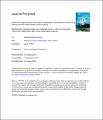| dc.contributor.author | Kiani, Sepideh | |
| dc.contributor.author | Kujala, Katharina | |
| dc.contributor.author | Pulkkinen, Jani | |
| dc.contributor.author | Aalto, Sanni L. | |
| dc.contributor.author | Suurnäkki, Suvi | |
| dc.contributor.author | Kiuru, Tapio | |
| dc.contributor.author | Tiirola, Marja | |
| dc.contributor.author | Kløve, Bjørn | |
| dc.contributor.author | Ronkanen, Anna-Kaisa | |
| dc.date.accessioned | 2021-01-15T06:31:46Z | |
| dc.date.available | 2021-01-15T06:31:46Z | |
| dc.date.issued | 2020 | |
| dc.identifier.citation | Kiani, S., Kujala, K., Pulkkinen, J., Aalto, S. L., Suurnäkki, S., Kiuru, T., Tiirola, M., Kløve, B., & Ronkanen, A.-K. (2020). Enhanced nitrogen removal of low carbon wastewater in denitrification bioreactors by utilizing industrial waste toward circular economy. <i>Journal of Cleaner Production</i>, <i>254</i>, Article 119973. <a href="https://doi.org/10.1016/j.jclepro.2020.119973" target="_blank">https://doi.org/10.1016/j.jclepro.2020.119973</a> | |
| dc.identifier.other | CONVID_33986388 | |
| dc.identifier.uri | https://jyx.jyu.fi/handle/123456789/73644 | |
| dc.description.abstract | Aquaculture needs practical solutions for nutrient removal to achieve sustainable fish production. Passive denitrifying bioreactors may provide an ecological, low-cost and low-maintenance approach for wastewater nitrogen removal. However, innovative organic materials are needed to enhance nitrate removal from the low carbon effluents in intensive recirculating aquaculture systems (RAS). In this study, we tested three additional carbon sources, including biochar, dried Sphagnum sp. moss and industrial potato residues, to enhance the performance of woodchip bioreactors treating the low carbon RAS wastewater. We assessed nitrate (NO3−) removal and microbial community composition during a one-year in situ column test with real aquaculture wastewater. We found no significant differences in the NO3− removal rates between the woodchip-only bioreactor and bioreactors with a zone of biochar or Sphagnum sp. moss (maximum removal rate 31–33 g NO3−-N m−3 d−1), but potato residues increased NO3− removal rate to 38 g NO3−-N m−3 d−1, with stable annual reduction efficiency of 93%. The readily available carbon released from potato residues increased NO3−-N removal capacity of the bioreactor even at higher inflow concentrations (>52 mg L−1). The microbial community and its predicted functional potential in the potato residue bioreactor differed markedly from those of the other bioreactors. Adding potato residues to woodchip material enabled smaller bioreactor size to be used for NO3− removal. This study introduced industrial potato by-product as an alternative carbon source for the woodchip denitrification process, and the encouraging results may pave the way toward growth of blue bioeconomy using the RAS. | en |
| dc.format.mimetype | application/pdf | |
| dc.language | eng | |
| dc.language.iso | eng | |
| dc.publisher | Elsevier | |
| dc.relation.ispartofseries | Journal of Cleaner Production | |
| dc.rights | CC BY-NC-ND 4.0 | |
| dc.subject.other | recirculating aquaculture system | |
| dc.subject.other | woodchip bioreactor | |
| dc.subject.other | carbon source | |
| dc.subject.other | potato residues | |
| dc.subject.other | nitrate | |
| dc.subject.other | microbial community | |
| dc.title | Enhanced nitrogen removal of low carbon wastewater in denitrification bioreactors by utilizing industrial waste toward circular economy | |
| dc.type | article | |
| dc.identifier.urn | URN:NBN:fi:jyu-202101151120 | |
| dc.contributor.laitos | Bio- ja ympäristötieteiden laitos | fi |
| dc.contributor.laitos | Department of Biological and Environmental Science | en |
| dc.contributor.oppiaine | Akvaattiset tieteet | fi |
| dc.contributor.oppiaine | Ympäristötiede | fi |
| dc.contributor.oppiaine | Aquatic Sciences | en |
| dc.contributor.oppiaine | Environmental Science | en |
| dc.type.uri | http://purl.org/eprint/type/JournalArticle | |
| dc.type.coar | http://purl.org/coar/resource_type/c_2df8fbb1 | |
| dc.description.reviewstatus | peerReviewed | |
| dc.relation.issn | 0959-6526 | |
| dc.relation.volume | 254 | |
| dc.type.version | acceptedVersion | |
| dc.rights.copyright | © Elsevier Ltd. | |
| dc.rights.accesslevel | openAccess | fi |
| dc.relation.grantnumber | 311984 | |
| dc.subject.yso | denitrifikaatio | |
| dc.subject.yso | jäteveden käsittely | |
| dc.subject.yso | kiertotalous | |
| dc.subject.yso | biohiili | |
| dc.subject.yso | peruna | |
| dc.subject.yso | bioreaktorit | |
| dc.subject.yso | vesiviljely (kalatalous) | |
| dc.format.content | fulltext | |
| jyx.subject.uri | http://www.yso.fi/onto/yso/p12487 | |
| jyx.subject.uri | http://www.yso.fi/onto/yso/p17761 | |
| jyx.subject.uri | http://www.yso.fi/onto/yso/p28601 | |
| jyx.subject.uri | http://www.yso.fi/onto/yso/p27826 | |
| jyx.subject.uri | http://www.yso.fi/onto/yso/p13407 | |
| jyx.subject.uri | http://www.yso.fi/onto/yso/p37822 | |
| jyx.subject.uri | http://www.yso.fi/onto/yso/p5099 | |
| dc.rights.url | https://creativecommons.org/licenses/by-nc-nd/4.0/ | |
| dc.relation.doi | 10.1016/j.jclepro.2020.119973 | |
| dc.relation.funder | Research Council of Finland | en |
| dc.relation.funder | Suomen Akatemia | fi |
| jyx.fundingprogram | Others, AoF | en |
| jyx.fundingprogram | Muut, SA | fi |
| jyx.fundinginformation | This study was funded by the Maa- ja vesitekniikan tuki ry. [grant no. 37413], Natural Resources Institute 467 Finland (LUKE), KAUTE-Säätiö and Olvi-säätiö, and by the European Union BONUS Blue Baltic (Art 185) 468 CLEANAQ project partly funded by the Academy of Finland [grant no. 311984] | |
| dc.type.okm | A1 | |

